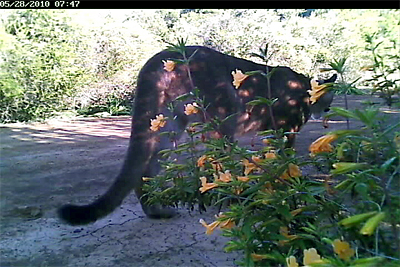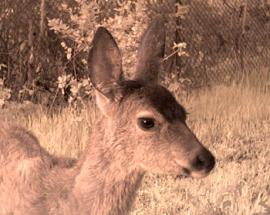Wildlife Management
Mountain Lions at Jasper Ridge Biological Preserve:
An Exercise in Management and Policy Options
 This report was authored by five members of the Rising Environmental Leaders Network (RELN) at Stanford. The RELN is a project at the Woods Institute for the Environment modeled after the Aldo Leopold Leadership Program but designed for postdoctoral fellows and PhD students. As part of their one-year training program, the RELN members were invited to participate in a one-week, interdisciplinary problem-solving workshop in Sept 2010 focused on an issue at Jasper Ridge. The goal of the workshop was to focus on an issue that combines science, policy, public outreach, and provides near-term benefit for a client – in this case, Jasper Ridge.
This report was authored by five members of the Rising Environmental Leaders Network (RELN) at Stanford. The RELN is a project at the Woods Institute for the Environment modeled after the Aldo Leopold Leadership Program but designed for postdoctoral fellows and PhD students. As part of their one-year training program, the RELN members were invited to participate in a one-week, interdisciplinary problem-solving workshop in Sept 2010 focused on an issue at Jasper Ridge. The goal of the workshop was to focus on an issue that combines science, policy, public outreach, and provides near-term benefit for a client – in this case, Jasper Ridge.
RELN participants were asked to approach the issue of mountain lions at Jasper Ridge from a multidisciplinary perspective based on interviews with experts in the areas of mountain lion ecology, risk assessment, graphic communication, institutional liability, university policy on research on wild animals, and regional conservation and coordination. Professors Nicole Ardoin and Christopher Field outlined the goals of the workshop.
Specifically, the RELN participants were asked to address the following three questions:
- How should the risks from mountain lion presence be evaluated, managed, and conveyed to Jasper Ridge users?
- How should the camera trap data on mountain lions be used and shared–and on what time frame–for scientific, educational, or management purposes, especially regarding biological corridors that traverse JRBP?
- Are there unique opportunities for Jasper Ridge to contribute to research and communication on mountain lion ecology in ways that are consistent with Stanford's research policies?
Click Here to download the report (PDF format)
JRBP Camera Trap Photo and Video Gallery
 Wireless digital camera traps are providing unprecedented and detailed information on some of JRBP's big unknowns, such as the abundance and behavior of large predators and the nature of biological corridors linking JRBP to other areas.
Wireless digital camera traps are providing unprecedented and detailed information on some of JRBP's big unknowns, such as the abundance and behavior of large predators and the nature of biological corridors linking JRBP to other areas.
By silently recording whatever passes by--whether a mountain lion, jackrabbit, or even an occasional trespasser-- the cameras will help JRBP address many challenges that characterize the wildland/suburban interface.



